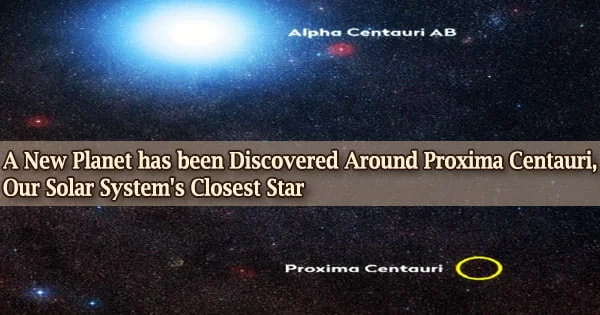Astronomers using the European Southern Observatory’s Very Large Telescope (ESO’s VLT) in Chile discovered evidence of another planet around Proxima Centauri, our Solar System’s closest star.
Proxima Centauri is a tiny, low-mass star in the southern constellation of Centaurus, located 4.2465 light-years (1.3020 pc) from the Sun. Its Latin name means ‘Centaurus’s nearest (star).’ Robert Innes found it in 1915, and it is the closest known star to the Sun.
This candidate planet is the third to be discovered in the system, and it is the lightest to yet. The planet is also one of the lightest exoplanets yet discovered, weighing only a fourth of Earth’s mass.
“The discovery shows that our closest stellar neighbor seems to be packed with interesting new worlds, within reach of further study and future exploration,” explains João Faria, a researcher at the Instituto de Astrofísica e Ciências do Espaço, Portugal, and lead author of the study published today in Astronomy & Astrophysics.
The closest star to the Sun is Proxima Centauri, which is slightly over four light-years away. Proxima d, the newly discovered planet, orbits Proxima Centauri at a distance of around four million kilometers, less than a tenth of the distance Mercury is from the Sun.
It travels between the star and the habitable zone, which is the region surrounding a star where liquid water can exist on a planet’s surface and completes one orbit around Proxima Centauri in just five days. Proxima’s classification as a free-floating star has long been questioned by astronomers.
They were able to calculate not only its distance but also its mobility through space by tracking its position over time. Convection throughout the stellar body creates the star’s magnetic field, and the resulting flare activity produces a total X-ray emission similar to that of the Sun.
This achievement is extremely important. It shows that the radial velocity technique has the potential to unveil a population of light planets, like our own, that are expected to be the most abundant in our galaxy and that can potentially host life as we know it.
Pedro Figueira
Proxima b, a planet with a mass comparable to Earth that rounds the star every 11 days and is within the habitable zone, and candidate Proxima c, a planet with a longer five-year orbit around the star, are both known to orbit the star.
The HARPS instrument on ESO’s 3.6-metre telescope was used to detect Proxima b a few years ago. The discovery was confirmed in 2020 when scientists used a new equipment on ESO’s VLT, the Echelle SPectrograph for Rocky Exoplanets and Stable Spectroscopic Observations (ESPRESSO), to investigate the Proxima system with higher precision.
Astronomers discovered the first signs of a signal belonging to an object with a five-day orbit during these more recent VLT measurements. Because the signal was so weak, the scientists had to do follow-up observations with ESPRESSO to ensure that it was caused by a planet rather than changes in the star itself.
“After obtaining new observations, we were able to confirm this signal as a new planet candidate,” Faria says. “I was excited by the challenge of detecting such a small signal and, by doing so, discovering an exoplanet so close to Earth.”
Proxima d, with a mass of only a quarter that of Earth, is the lightest exoplanet yet identified using the radial velocity approach, surpassing a planet discovered lately in the L 98-59 planetary system.
The method works by detecting minuscule wobbles in a star’s velocity caused by the gravitational pull of an orbiting planet. Proxima Centauri moves back and forth at a rate of roughly 40 centimetres per second due to the action of Proxima d’s gravity (1.44 kilometres per hour).
The presence of Proxima, according to Dr. Jeremy Wertheimer and Dr. Gregory Laughlin of the Lick Observatory in California, could help stir up the gas and dust in the system, allowing Earth-like worlds to emerge. Using the most recent data on Proxima’s motion, Wertheimer and Laughlin conclude that Proxima is most likely caught in Alpha’s gravitational field.
“This achievement is extremely important,” says Pedro Figueira, ESPRESSO instrument scientist at ESO in Chile. “It shows that the radial velocity technique has the potential to unveil a population of light planets, like our own, that are expected to be the most abundant in our galaxy and that can potentially host life as we know it.”
“This result clearly shows what ESPRESSO is capable of and makes me wonder about what it will be able to find in the future,” Faria adds.
Proxima Centauri b orbits the star at a distance of around 0.05 AU (7.5 million kilometers) and has an orbital period of about 11.2 Earth days. Its mass is believed to be 1.17 times that of Earth.
ESO’s Extremely Large Telescope (ELT), which is now under construction in the Atacama Desert and will be critical in locating and researching many more planets around nearby stars, will complement ESPRESSO’s hunt for other worlds.
















